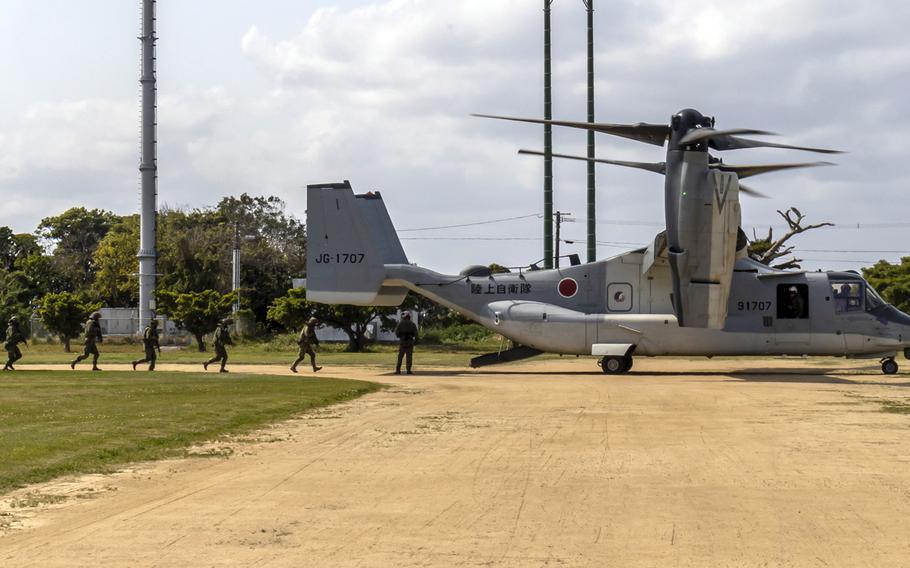
Japanese soldiers board a V-22 Osprey while training with U.S. forces in Tokunoshima, Japan, March 2, 2023. (Manuel Alvarado/U.S. Marine Corps)
CAMP FOSTER, Okinawa — A Japanese V-22 Osprey landed in Okinawa for the first time Thursday to train with the U.S. military, despite a request from the prefectural government to exclude the tiltrotor aircraft.
The Ground Self-Defense Force Osprey touched down at New Ishigaki Airport on Ishigaki Island, 160 miles east of Taiwan, around 10:50 a.m., a Ground Staff Office spokesman wrote in an emailed statement Friday. It first made stops at Ground Self-Defense Force Vice Camps Takayubaru and Setouchi in Kumamoto and Kagoshima prefectures, respectively.
The tiltrotor took on simulated casualties before flying back to Takayubaru at 1:10 p.m., he said. The Ground Self-Defense Force plans to repeat the evacuation drill again on Tuesday.
It’s customary in Japan for some government officials to speak to the media on condition of anonymity.
The drill was part of Resolute Dragon, an annual multidomain exercise with the U.S. military that kicked off Oct. 15 and runs through Oct. 31 at locations across Japan.
After the Osprey landed at Ishigaki, Okinawa Gov. Denny Tamaki took to X, formerly known as Twitter, to express disappointment that his request had not been granted. The prefecture asked the Okinawa Defense Bureau, which represents Japan’s Defense Ministry on the island, to refrain from flying V-22s to the prefecture on Sept. 13 and again on Tuesday.
The use of Ospreys “causes anxiety for Okinawa’s population,” Tamaki wrote in his post Thursday. He vowed to continue to advocate against the tiltrotors.
Japanese Chief Cabinet Secretary Hirokazu Matsuno responded that Ospreys are “essential” for moving Self-Defense Force personnel to remote islands and that every effort was made to minimize impacts on the local population, according to a video posted Thursday to Prime Minister Fumio Kishida’s website.
“It is important to strengthen the deterrence and the response capability of the U.S.-Japan partnership to protect our islands,” Matsuno said, calling the current situation the most “complex security environment since the end of World War II.”
The Osprey has been a point of contention in Japan since it first arrived at Marine Corps Air Station Iwakuni on the main island of Honshu in July 2012. The aircraft’s development history, coupled with several high-profile crashes, has made it the target of an Okinawa protest movement.
Three Marines died and several others were hospitalized in Australia on Aug. 27 when their Osprey crashed during the multinational Talisman Sabre exercise. Two days later, Gen. Eric Smith, then-assistant commandant of the Marine Corps, ordered a “thorough and harsh” safety review.
The Japanese government selected the helicopter-plane hybrid in 2014 due to its speed and versatility. Japan has received 14 out of 17 planned, thus far; the fleet is based at Camp Kisarazu in Chiba prefecture.
Resolute Dragon, conducted primarily with elements of the Okinawa-based III Marine Expeditionary Force, involves thousands of U.S. Marines and Japanese troops in stand-in force exercises, including command and control, precision fires and maneuvering.
A stand-in force — a key tenet of the Marine Corps’ Force Design 2030 — is a smaller, mobile unit inserted within range of enemy missiles to seize and hold key islands and deny enemy vessels access to surrounding seas.
The policy is geared toward blunting China’s maritime expansion; the communist nation was labeled the top global “pacing challenge” in the Pentagon’s 2022 National Defense Strategy.